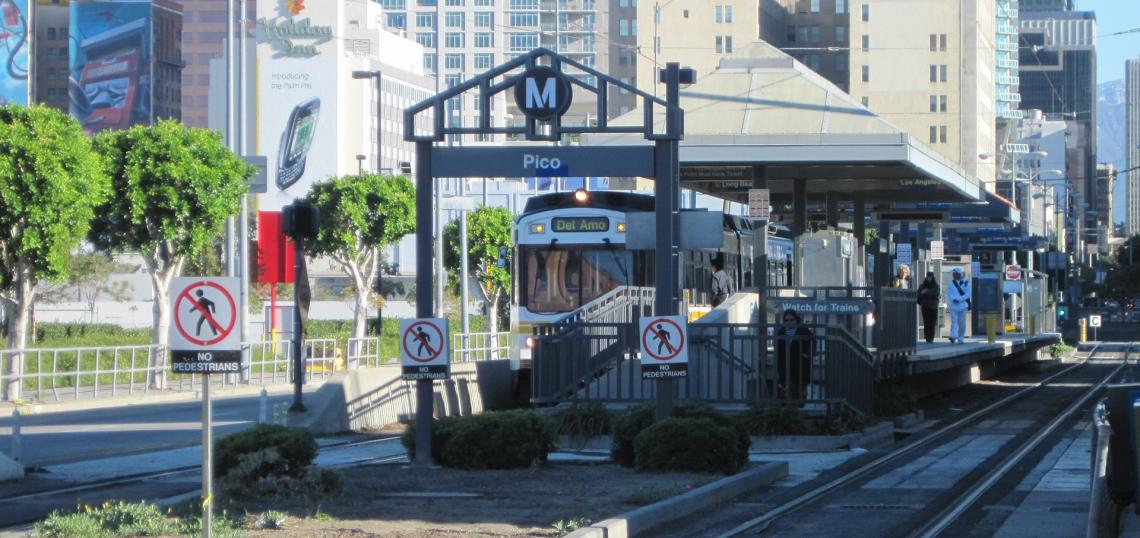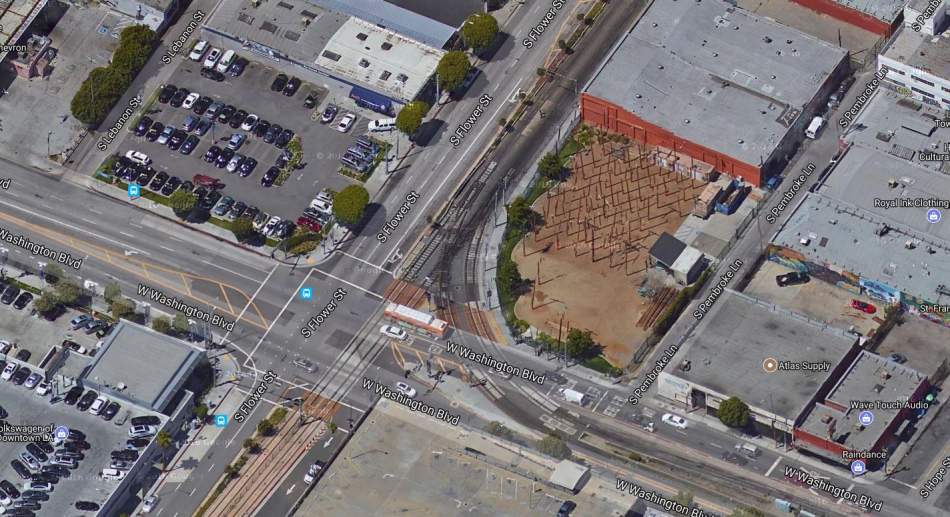During February’s meeting of the Metro Board of Directors, as part of what Mayor Garcetti referred to as the Board’s commitment to the system’s legacy lines, the directors passed a motion to study a suite of improvements to the Blue Line that would increase passenger safety while making trips between Los Angeles and Long Beach “faster and better.” Metro staff was directed to report back to the board on the viability of a host of options, including grade separations for the wye junction connecting the Blue and Expo Lines at Washington Boulevard as well as for Pico station.
The motion, penned by Directors Garcetti, Hahn, Garcia and Dupont-Walker, was prompted by sagging rider approval for the workhorse light rail line in recent years. Discontent with the Blue Line has apparently come to a head, as ridership has plummeted over the course of the last year. Things actually looked promising last summer. In the July-to-September quarter, ridership was up 8% over the same period in 2015, but the situation rapidly deteriorated from there. For the recently ended budget year, the Blue Line logged its worst ridership numbers in a decade.
To a certain extent, the completion of the Expo Line last summer, and its corresponding gradual service increase, appear to be linked to the Blue Line’s woes . It makes sense then, that the segment of track between the 7th Street/Metro Center shared terminus and the Washington Boulevard wye junction figures centrally in Metro’s proposals. Both trains run primarily at-grade through this congested stretch of downtown Los Angeles, and as a new staff report notes, delays resulting from the practical problems of operating in traffic have a “domino effect” throughout the Blue and Expo Lines. This month, Metro’s Operations committee will receive that report, which contains the preliminary analysis and cost estimates of alternatives to disentangle the rail lines from traffic and from each other.
The alternatives - labeled WP1, WP2 WP3 - were developed from seven possible new configurations of the Washington junction, and three possible designs for Pico Station.
The first alternative, WP1, would grade-separate Pico station and rebuild it with two platforms and four tracks to increase passenger capacity and alleviate train congestion. The junction would be left largely as is, with a grade separation for the northbound Expo track. The option is projected to cost $330 million, but the staff report anticipates potential issues of community acceptability, noting: “Should the impacts of these aerial structures not be acceptable to the businesses and communities, the same concept can be designed by undergrounding instead of elevating the Expo northbound track and Pico Station.” Undergrounding Pico Station is expected to cost an additional $120 million, while a cost is not provided for putting the northbound Expo track below grade.
WP2 proposes to go further, extending the subway alignment of the Expo Line from 7th/Metro past Washington, eliminating the existing junction entirely. The Blue Line under this alternative would remain at street level, and Pico station would be stacked, with Blue Line trains above and Expo trains running below. The alternative is estimated at $680 million.
WP3, the final alternative that staff recommended to be carried forward, fully grade separates the Washington junction by putting all southbound trains on Flower into a subway alignment and elevating northbound trains above street level until they reach the 10 freeway, at which point they would continue at grade. Pico Station would again be stacked, but with northbound trains at the existing station, and southbound trains underground. The alternative is estimated by staff at $840 million.
Notably, none of the alternatives directly eliminates all of the Blue Line’s interactions with car traffic. The priority seems to be more on separating Blue and Expo from one another. WP1 does address one of the biggest complaints of Expo riders, the seemingly interminable delays for L.A.-bound trains that wait behind Blue Line trains headed in either direction. It does not, however, do much to ameliorate the situation for the Blue Line, aside from presumably providing for a grade separation over Pico Boulevard. WP2 goes even further, leaving the Blue Line completely untouched, while taking Expo entirely off street level.
WP3 has issues of its own. In simply ignoring Grand station, which would have to be either reconstructed or eliminated, it seems to disregard a major cost and a potential source of community resistance as well. Furthermore, it seems to show the extent to which Metro’s staff attempted to prioritize grade separating the Blue and Expo lines from one another. While this may seem like good practice, there’s a dubious effect to complete separation between the lines south of 7th street, while they still share tracks elsewhere along the Regional Connector.
To my mind, there doesn’t seem to be a good reason to try so hard to avoid an underground flat junction at Washington. The first priority should be getting both train lines off of street level at the junction, and to the extent possible, eliminating at-grade crossings elsewhere. The cost estimates appear to be reasonable for such a heavily-traveled segment of the Metro network.
However, the costs provided are themselves somewhat obscure in the report. Whereas the cost of WP1 is actually equal to the cost of W1 + P1, the same is not true for either of the other alternatives. The cost for WP2, $680 million, is the same as the estimate for W4 without any indication of the $290 million assumed cost of the stacked Pico station alternative. If $680 million is what it costs to tunnel Expo from 7th Street to near 23rd Street, are we to understand that there is no additional cost to building a station, or that the cost is for some reason already priced in? It’s unclear.
Conversely with WP3, the cost of the alternative is greater than the sum of its parts, which at $460 million for the aerial and underground treatment for the junction and $290 million for the stacked Pico Station, comes out to $750 million. If the additional $90 million represents the cost to tunnel between Washington and Pico Station, it is again not entirely clear here.
For the purposes of our analysis, I will assume that the WP2 and the WP3 costs are correct, but that the component cost listed for undergrounding Expo at the junction is incorrect. If this is the case, the actual cost of putting Expo below grade at the junction should be: $680 million (total) - $290 million (stacked Pico station) - $90 million (tunneling Expo from 7th to Washington) = $300 million.
We can use this to estimate the cost of another alternative: running both the Blue and Expo lines in a subway alignment from 7th Street with a fully below grade junction matching the one on the other end of the Regional Connector in Little Tokyo. The total for such an alternative would be approximately $800 million ($360 million for a four-tracked underground Pico, $90 million to tunnel, $300 million for grade separating Expo at the junction, and an extra $50 million for including Blue in a flat underground junction). If an extra underground station were to be added in, consolidating the duplicative LATTC stops, that would bring the total to around $1 billion. This estimate is rough because Metro staff made the somewhat perplexing decision not to carry the flat underground junction forward from preliminary consideration.
In terms of cost efficiency, the Regional Connector is probably the strongest project that Metro is currently planning, with its projected 90,000 daily boardings and total cost of $1.75 billion coming out to about $20,000 per rider. The extension of the Flower Street subway would need to attract 50,000 daily boardings to achieve the same cost per rider, and it already averages around 40,000 today. It seems likely to me that a full analysis of the subway alternative would bear out that this project would be a worthwhile investment.
None of this is to say this would be an easy project to complete. If carried forward, grade separating Metro’s two busiest light rail lines will be extremely disruptive to the commutes of tens of thousands of Angelenos. But whatever the choice Metro makes, it should be one that most meaningfully benefits riders of both lines, and allows for continued high quality service on an increasingly significant transit corridor.
Scott covers transportation and governance issues from his home in Silver Lake. Follow him on Twitter @safrazie.










